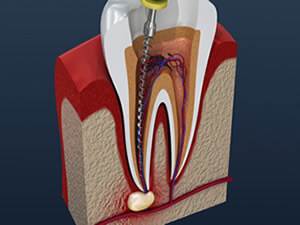
A root canal treatment has to be performed if the dental nerve technically called the dental pulp from the Latin Popa has died or is infected. The patient may or may not experience pain after pulp death. Some causes of pulp death include deep-seated caries, severe heat generation during tooth repair, severe periodontitis, or possibly chemicals used by the dentist.
The tooth is connected to the bone through numerous small canals at the end of the root. The objective of a root canal treatment is to completely remove the destroyed tissue which may also be infected with bacteria in some cases from the interior of a tooth. This way the infection is prevented from spreading to the bone since complete cleaning of the interior of a tooth is never 100% successful the dentist attempts to close the pulp cavity with a compound so that any remaining bacteria don’t have space to multiply. This means that absolute cleanliness and a sterile working environment are prerequisites for any root canal treatment. In order to create this environment in the oral cavity, it’s imperative that the dentist works with a rubber dam because that’s the only way to prevent saliva from reaching the interior of a tooth. Saliva contains many different bacteria that can endanger the success of a root canal treatment.
Sterile Instruments
With the aid of sterile instruments the dentist begins to clear and clean the interior of the tooth. Special solutions are used intermittently for irrigation in order to flush out tooth tips cell debris and bacteria. It’s important that all canals are reconditioned. Most teeth have several canals, therefore a root canal specialist a so-called endodontic specialist, always works with magnification such as medical magnifying glasses or a microscope on the dental canal.
Root Apex
The length of the root is ascertained by means of x-rays and measuring aids only a well-conditioned tooth filled all the way to the root. If the tooth exudes a foul smell is painful or bleeds severely from within the canal, it should not be filled with the permanent material. In such cases medication is applied within the canal which is then tightly sealed for a few days with temporary sealing material. Only then will it keep the tooth sealed for about one week. Another cleaning session must take place no longer than a week after the initial session. If this is not done, bacteria from the saliva could enter the tooth and its canals necessitating a repeat of the entire previous procedure. Once the canals are clean and the tooth no longer causes any discomfort the canals are tightly filled with a special compound creating a tight apical seal.